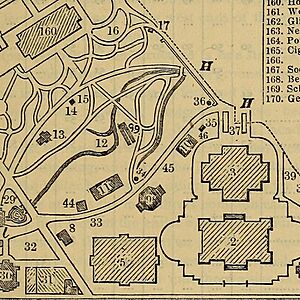Centennial comfort stations facts for kids
The Centennial comfort stations are two special brick buildings in Fairmount Park in Philadelphia. They were built a long time ago, in 1876, for a big event called the Centennial Exposition. Think of it like a huge world's fair! These buildings were originally used as public restrooms for visitors. Today, they are being fixed up and made new again.
Contents
History of the Buildings
These two buildings are very unique because they might be the only restrooms left from a big international fair in the 1800s. They were built with strong brick, wood, slate roofs, and copper details. Each building is about 20 feet (6 meters) by 22 feet (6.7 meters) and has one story.
During the 1876 Exposition, there were seven public restrooms built. More than 200 other buildings were also constructed for the fair. Only four of these original buildings are still standing in their first locations today: Memorial Hall, the Ohio State Building, and these two comfort stations.
Why They Were Built to Last
One of the main buildings at the fair was the Horticulture Building, which was meant to be a permanent structure. The comfort stations were probably built with strong brick so they could continue to be used by visitors to the Horticulture Building.
However, the Horticulture Building was torn down in 1955. After that, the comfort stations were used for storage and started to get old and worn out.
New Life for Old Buildings
A new Horticulture Center was built in 1976, right next to the comfort stations. This was for another big celebration, the United States Bicentennial (200 years of the USA!).
In 2011, work began to fix up the comfort stations. They are now being used by the Shofuso Japanese House and Gardens. The building on the east side is now a cool exhibition space. The building on the west side is being fixed up to be a restroom again.
These comfort stations are part of a special list called the National Register of Historic Places. This list helps protect important historic places.
Images for kids










